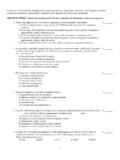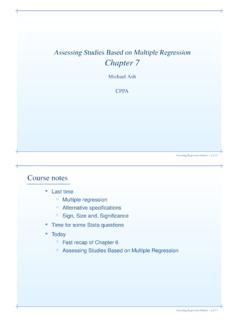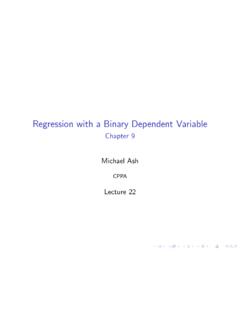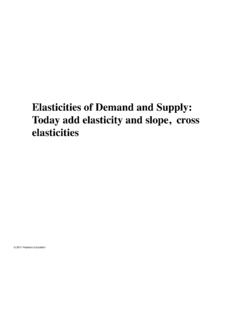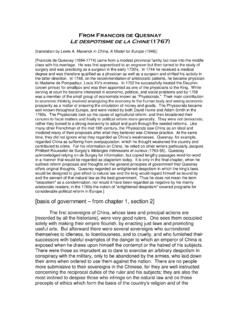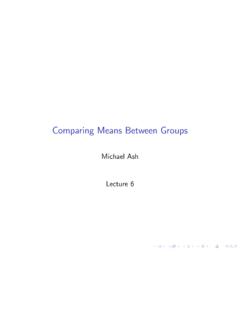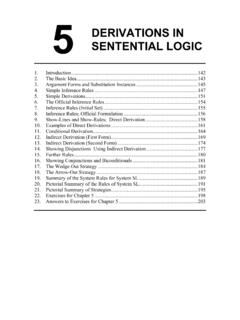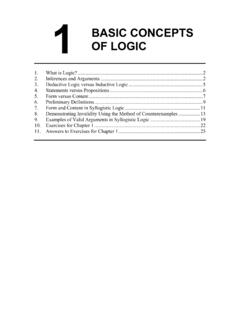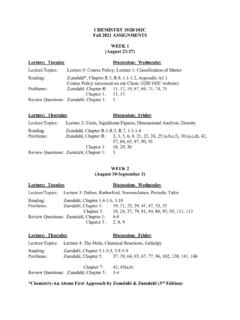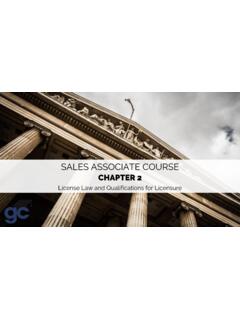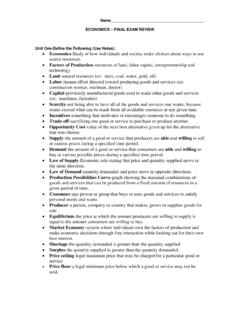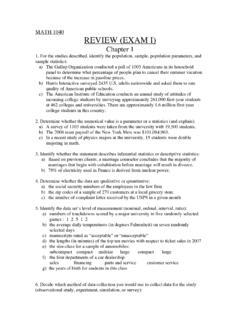Transcription of Fall 2012 Economics 103h: Review questions for final exam ...
1 fall 2012 Economics 103h : Review questions for final exam, part 2 Below are the remaining questions on monopolistic competition and on oligopoly. Short answer/graphing questions on oligopoly ( Review questions part 1 had questions on monopolistic competition). 1. Draw on a graph and explain in words how firms collude to make monopoly profits. 2. Draw on a graph and explain in words what happens to industry price and quantitty if one firm cheats. 3. Draw on a graph and explain in words what happens to the price and output in the industry when two firms cheat.
2 Draw a graph for the individual firm and a graph for the industry. 4. Draw and explain a duopoly payoff matrix. 5. Draw and explain a prisoners dilemma payoff matrix. Multiple choice questions 1) Monopolistic competition is a market structure in which: A) A small number of firms compete. B) Firms produce identical products. C) Firms compete only on product price. D) Firms are free to enter and exit the market. Answer: D 2) In monopolistic competition, a firm has some ability to affect the price for its product because of A) easy entry and exit.
3 B) economic profits. C) product differentiation. D) many competitors. Answer: C 3) Monopolistic competition differs from monopoly because in monopolistic competition A) firms maximize profits. B) firms set marginal revenue equal to marginal cost to maximize profit. C) firms are free to enter and exit. D) All of the above are differences between monopoly and monopolistically competitive firms. Answer: C 4) Which of the following best explains why monopolistically competitive firms face a downward sloping demand curve while perfectly competitive firms do not?
4 A) monopolistically competitive firms sell a differentiated good B) monopolistically competitive industries have only a few firms C) monopolistically competitive firms have barriers to entry D) only industries with free entry and exit have firms that face horizontal demand curves Answer: A 5) Firms in monopolistic competition make products that are A) perfect complements. B) close but not perfect complements. C) perfect substitutes. D) close but not perfect substitutes. Answer: D 6) The best example of a good sold in a monopolistically competitive market is A) pizza.
5 B) the local newspaper. C) sewer services. D) peaches. Answer: A 7) In monopolistic competition, each firm has a demand curve with a _____ and there _____ barriers to entry into the market. A) negative slope; are no B) slope equal to zero; are no C) negative slope; are D) slope equal to zero; are Answer: A 8) In monopolistic competition, each firm's marginal revenue curve lies _____ its demand curve because of _____. A) below ; barriers to entry B) below; product differentiation C) above; barriers to entry D) above; product differentiation Answer: B 9) In monopolistic competition, each firm's marginal revenue curve has a _____ and its demand curve has a _____.
6 A) slope equal to zero; slope equal to zero B) slope equal to zero; negative slope C) negative slope; a slope equal to zero D) negative slope; negative slope Answer: D 10) A firm in monopolistic competition has some degree of price-setting power because A) in the long run it earns a normal profit. B) it can never earn less than normal profit. C) the price it charges is never more than its marginal cost. D) if it raises its price, the quantity it can sell will not decrease to zero. Answer: D 11) For a firm in monopolistic competition, the marginal cost curve intersects the average total cost curve A) at the minimum average total cost.
7 B) to the left of the minimum average total cost. C) to the right of the minimum average total cost. D) at no point. Answer: A 12) In the short run, a monopolistically competitive firm chooses A) both its price and its quantity. B) its price but not its quantity. C) its quantity but not its price. D) neither its price nor its quantity. Answer: A 13) In the short run, a firm in monopolistic competition produces where A) MR = MC and economic profit is equal to zero. B) MR = MC. C) the given market price is equal to MC and economic profit is equal to zero.
8 D) the given market price is equal to MC. Answer: B 14) How is a monopolistically competitive firm similar to a monopoly firm? A) both produce where marginal revenue equals marginal cost B) both will observe entry into the industry if economic profit is positive C) both produce a unique good D) both produce where price equals marginal cost Answer: A 15) In the short run, for a firm in monopolistic competition, A) the firm's economic profit must equal zero. B) marginal revenue exceeds marginal cost. C) price exceeds marginal cost.
9 D) the firm is a price taker. Answer: C 16) In monopolistic competition, firms can make an economic profit in A) the short run and in the long run. B) the short run but not in the long run. C) the long run but not in the short run. D) neither the long run nor the short run. Answer: B 17) In the above figure, if the firm is in monopolistic competition, it will produce A) 40 units. B) 60 units. C) between 61 and 99 units. D) 100 units. Answer: A 18) In the above figure, if the firm is in monopolistic competition, its price will be A) $1.
10 B) $2. C) $3. D) $4. Answer: C 19) In the above figure, the monopolistically competitive firm makes an economic profit of A) $0. B) between $0 and $50 per day. C) between $ and $100 per day. D) greater than $ per day. Answer: B 20) The above figure is for a firm in monopolistic competition. The diagram represents the short run rather than the long run because the A) MR curve cuts the ATC curve from below. B) MR curve and the D curve do not coincide. C) firm is incurring an economic loss. D) firm is making an economic profit. Answer: D 21) In a monopolistically competitive industry, the firms are currently making an economic profit.
